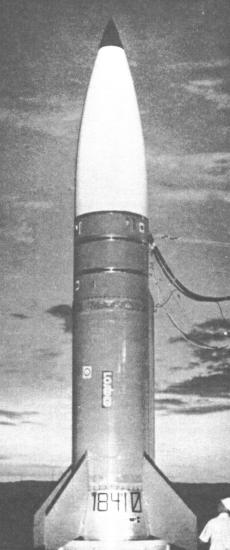Orbital Sciences (Space Vector) Aries
The retirement of the U.S. Air Force's LGM-30A/B Minuteman I ICBM in the late 1960s and early 1970s made hundreds of high-performance solid-fueled rocket stages surplus. In 1971, the Naval Research Laboratory (NRL) realized, that the second stage of the Minuteman I could be used to create a powerful single-stage sounding rocket, and contracted Space Vector Corp. (SVC) to build this vehicle. The rocket was initially called "Fat Albert", but the name was soon changed to Aries. The first Aries was successfully launched with a dummy payload on 17 October 1973.
The Aries was essentially an Aerojet M56 solid-propellant rocket stage fitted with four fixed tail fins and a nose cone. The M56 was steered by four gimballed nozzles, and SVC developed a new guidance and control system which was more suited to sounding rockets than the one of the ICBM. Other than most sounding rockets, the Aries was thus a fully guided missile and could therefore be used from relatively confined firing ranges. It was also by far the most powerful single-stage sounding vehicle, and could lift a payload of 820 kg (1800 lb) to more than 320 km (200 miles). The highest apogee reached by an Aries was 512 km (318 miles).
 |
 |
|
| Photo: John McDaniel, via Peter Alway | Photo: Fred Williams & Matt Steele, via Peter Alway | |
| Aries (prototype) | Aries |
After the first two Aries tests, the configuration was slightly changed. The tail skirt was altered and the original fins (which had been taken from surplus RIM-8 Talos missiles) were replaced by a new design. The Aries was used by NASA to launch especially large and heavy payloads above the atmosphere, like X-ray and UV telescopes. Maximum payload capacity was 1590 kg (3500 lb). USAF and NASA launched more than 20 Aries rockets on scientific missions until the early 1990s.
The Aries was also used by the military as a target launch vehicle for tests of anti-ballistic missiles. The majority of these tests launched targets for the U.S. Navy's RIM-156B SM-2 Block IV A and RIM-161 SM-3 interceptor missiles. Until the end of 2004, a total of more than 50 Aries rockets has been launched, and use as a ballistic missile target vehicle is continuing. Current prime contractor for Aries-type target boosters is Orbital Sciences Corporation, which is calling the rocket the TTV (Target Test Vehicle).
Specifications
Note: Data given by several sources show slight variations. Figures given below may therefore be inaccurate!
Data for Aries (varying according to payload):
| Length | 7.80 m (25 ft 7 in) - 10.62 m (34 ft 10 in) |
| Diameter | 1.13 m (44.4 in) |
| Finspan | 2.86 m (9 ft 4.5 in) |
| Weight | 6060 kg (13370 lb) - 7150 kg (15760 lb) |
| Altitude | > 320 km (200 miles) |
| Propulsion | Aerojet M56 solid-fueled rocket; 207 kN (46500 lb) for 62 s |
Main Sources
[1] Peter Alway: "Rockets of the World", Saturn Press, 1999
[2] Frederick I. Ordway III, Ronald C. Wakeford: "International Missile and Spacecraft Guide", McGraw-Hill, 1960
[3] Mark Wade: Encyclopedia Astronautica
[4] Jonathan McDowell: Launch Vehicles Database
Back to Directory of U.S. Military Rockets and Missiles, Appendix 4
Last Updated: 5 October 2005